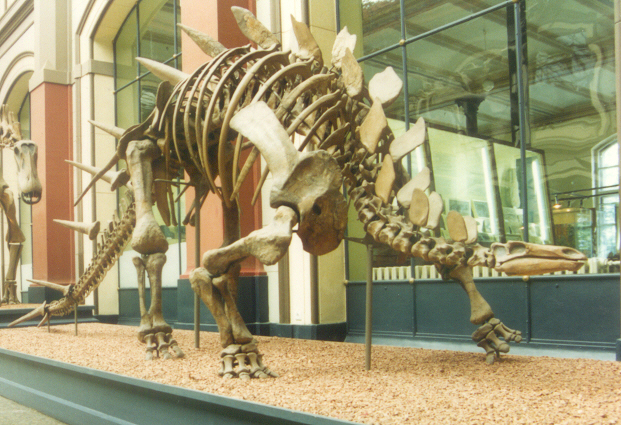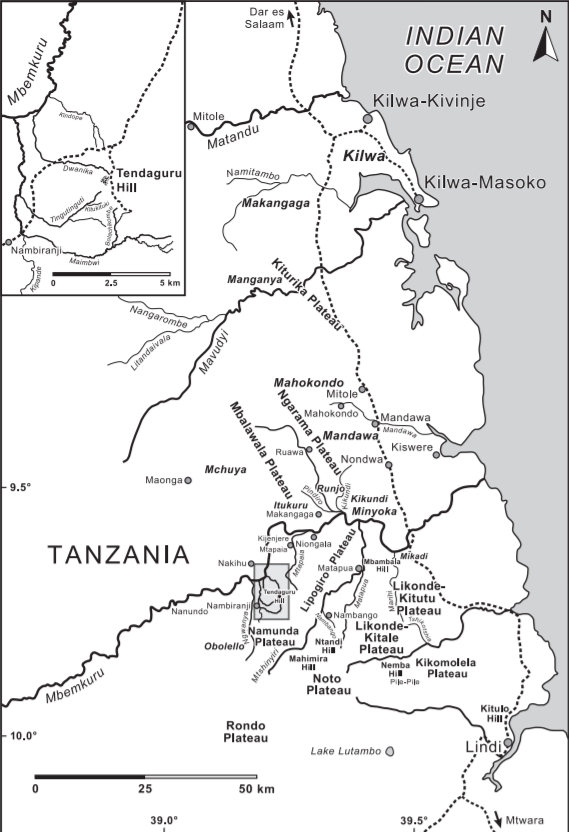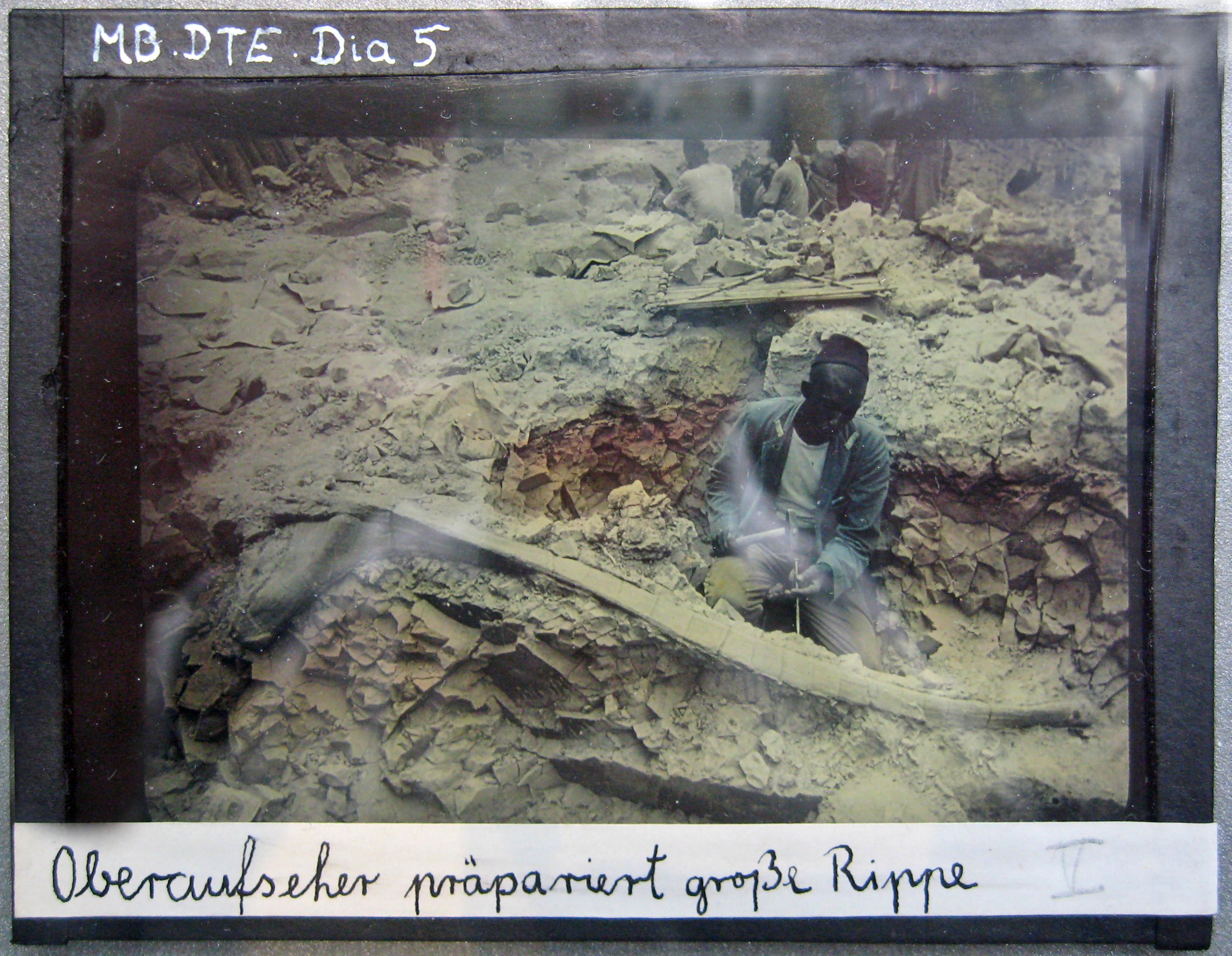|
Kentrosaurus
''Kentrosaurus'' ( ; ) is a genus of stegosaurid dinosaur from the Late Jurassic in Lindi Region of Tanzania. The type species is ''K. aethiopicus'', named and described by German palaeontologist Edwin Hennig in 1915. Often thought to be a " primitive" member of the Stegosauria, several recent cladistic analyses find it as more derived than many other stegosaurs, and a close relative of ''Stegosaurus'' from the North American Morrison Formation within the Stegosauridae. Fossils of ''K. aethiopicus'' have been found only in the Tendaguru Formation, dated to the late Kimmeridgian and early Tithonian ages, about 152 million years ago. Hundreds of bones were unearthed by German expeditions to German East Africa between 1909 and 1912. Although no complete skeletons are known, the remains provided a nearly complete picture of the build of the animal. In the Tendaguru Formation, it coexisted with a variety of dinosaurs such as the carnivorous theropods ''Elaphrosaurus'' and ''Veterupris ... [...More Info...] [...Related Items...] OR: [Wikipedia] [Google] [Baidu] |
Stegosauria
Stegosauria is a group of herbivorous ornithischian dinosaurs that lived during the Jurassic and early Cretaceous periods. Stegosaurian fossils have been found mostly in the Northern Hemisphere, predominantly in what is now North America, Europe, Africa, South America and Asia. Their geographical origins are unclear; the earliest unequivocal stegosaurian, ''Huayangosaurus taibaii'', lived in China. Stegosaurians were armored dinosaurs (thyreophorans). Originally, they did not differ much from more primitive members of that group, being small, low-slung, running animals protected by armored scutes. An early evolutionary innovation was the development of spikes as defensive weapons. Later species, belonging to a subgroup called the Stegosauridae, became larger, and developed long hindlimbs that no longer allowed them to run. This increased the importance of active defence by the thagomizer, which could ward off even large predators because the tail was in a higher position, pointing ... [...More Info...] [...Related Items...] OR: [Wikipedia] [Google] [Baidu] |
Stegosaurid
Stegosauridae is a family of thyreophoran dinosaurs (armoured dinosaurs) within the suborder Stegosauria. The clade is defined as all species of dinosaurs more closely related to ''Stegosaurus'' than ''Huayangosaurus''.David B. Weishampel, Peter Dodson, Halszka Osmólska. The ''Dinosauria'' (2nd ed.). Berkeley: University of California Press. The name ‘Stegosauridae’ is thus a stem-based name taken from the well-represented genus – ''Stegosaurus'' (meaning ‘roofed lizard’). Fossil evidence of stegosaurids, dating from the Middle Jurassic through the Early Cretaceous, have been recovered from North America, Eurasia and Africa. The clade Stegosauridae is composed of the genera ''Stegosaurus'', ''Dacentrurus'', '' Miragaia'', ''Loricatosaurus'', and ''Kentrosaurus'', with the last considered to be at the base of the clade. The stegosaurids like all other stegosaurians were quadrupedal herbivores that exhibited the characteristic stegosaurian dorsal dermal plates. These larg ... [...More Info...] [...Related Items...] OR: [Wikipedia] [Google] [Baidu] |
Stegosauridae
Stegosauridae is a family of thyreophoran dinosaurs (armoured dinosaurs) within the suborder Stegosauria. The clade is defined as all species of dinosaurs more closely related to ''Stegosaurus'' than ''Huayangosaurus''.David B. Weishampel, Peter Dodson, Halszka Osmólska. The ''Dinosauria'' (2nd ed.). Berkeley: University of California Press. The name ‘Stegosauridae’ is thus a stem-based name taken from the well-represented genus – ''Stegosaurus'' (meaning ‘roofed lizard’). Fossil evidence of stegosaurids, dating from the Middle Jurassic through the Early Cretaceous, have been recovered from North America, Eurasia and Africa. The clade Stegosauridae is composed of the genera ''Stegosaurus'', ''Dacentrurus'', '' Miragaia'', ''Loricatosaurus'', and ''Kentrosaurus'', with the last considered to be at the base of the clade. The stegosaurids like all other stegosaurians were quadrupedal herbivores that exhibited the characteristic stegosaurian dorsal dermal plates. These larg ... [...More Info...] [...Related Items...] OR: [Wikipedia] [Google] [Baidu] |
Stegosaurus
''Stegosaurus'' (; ) is a genus of herbivorous, four-legged, armored dinosaur from the Late Jurassic, characterized by the distinctive kite-shaped upright plates along their backs and spikes on their tails. Fossils of the genus have been found in the western United States and in Portugal, where they are found in Kimmeridgian- to early Tithonian-aged strata, dating to between 155 and 145 million years ago. Of the species that have been classified in the upper Morrison Formation of the western US, only three are universally recognized: ''S. stenops'', ''S. ungulatus'' and ''S. sulcatus''. The remains of over 80 individual animals of this genus have been found. ''Stegosaurus'' would have lived alongside dinosaurs such as ''Apatosaurus'', ''Diplodocus'', ''Brachiosaurus'', ''Ceratosaurus'', and ''Allosaurus''; the latter two may have preyed on it. They were large, heavily built, herbivorous quadrupeds with rounded backs, short fore limbs, long hind limbs, and tails held hi ... [...More Info...] [...Related Items...] OR: [Wikipedia] [Google] [Baidu] |
1916 In Paleontology
Plants Newly named angiosperms Fish Bony fish Dinosaurs Newly named dinosaurs Data courtesy of George Olshevsky's dinosaur genera list and Dr. Jeremy Montague's dinosaur genus database. Plesiosaurs Newly named taxa Synapsids Non-mammalian References {{portal, Paleontology 1910s in paleontology Paleontology Paleontology (), also spelled palaeontology or palæontology, is the scientific study of life that existed prior to, and sometimes including, the start of the Holocene epoch (roughly 11,700 years before present). It includes the study of fossi ... Paleontology 6 ... [...More Info...] [...Related Items...] OR: [Wikipedia] [Google] [Baidu] |
1915 In Paleontology
Arthropods Newly named insects Archosauromorphs Newly named pseudosuchians Newly named dinosaurs Data courtesy of George Olshevsky's dinosaur genera list. Anapsids Turtles Synapsids Non-mammalian Paleontologists * Death of Eberhard Fraas. References {{portal, Paleontology 1910s in paleontology Paleontology Paleontology (), also spelled palaeontology or palæontology, is the scientific study of life that existed prior to, and sometimes including, the start of the Holocene epoch (roughly 11,700 years before present). It includes the study of fossi ... Paleontology 5 ... [...More Info...] [...Related Items...] OR: [Wikipedia] [Google] [Baidu] |
Tendaguru Formation
The Tendaguru Formation, or Tendaguru Beds are a highly fossiliferous formation and Lagerstätte located in the Lindi Region of southeastern Tanzania. The formation represents the oldest sedimentary unit of the Mandawa Basin, overlying Neoproterozoic basement, separating by a long hiatus and unconformity. The formation reaches a total sedimentary thickness of more than . The formation ranges in age from the late Middle Jurassic to the Early Cretaceous, Oxfordian to Hauterivian stages, with the base of the formation possibly extending into the Callovian. The Tendaguru Formation is subdivided into six members; from oldest to youngest Lower Dinosaur Member, the ''Nerinella'' Member, the Middle Dinosaur Member, ''Indotrigonia africana'' Member, the Upper Dinosaur Member, and the ''Rutitrigonia bornhardti-schwarzi'' Member. The succession comprises a sequence of sandstones, shales, siltstones, conglomerates with minor oolitic limestones, deposited in an overall shallow marine to c ... [...More Info...] [...Related Items...] OR: [Wikipedia] [Google] [Baidu] |
Giraffatitan
''Giraffatitan'' (name meaning "titanic giraffe") is a genus of sauropod dinosaur that lived during the late Jurassic Period (geology), Period (Kimmeridgian–Tithonian stages) in what is now Lindi Region, Tanzania. It was originally named as an African species of ''Brachiosaurus'' (''B. brancai''), but this has since been moved to its own genus. ''Giraffatitan'' was for many decades known as the largest dinosaur but recent discoveries of several larger dinosaurs prove otherwise; giant titanosaurians appear to have surpassed ''Giraffatitan'' in terms of sheer mass. Also, the sauropod dinosaur ''Sauroposeidon'' is estimated to be taller and possibly heavier than ''Giraffatitan''. Most size estimates for ''Giraffatitan'' are based on the specimen HMN SII, a subadult individual, but there is evidence supporting that these animals could grow larger; specimen HMN XV2, represented by a fibula 13% larger than the corresponding material on HMN SII, might have attained in length and ... [...More Info...] [...Related Items...] OR: [Wikipedia] [Google] [Baidu] |
Edwin Hennig
Edwin Hennig (27 April 1882 – 12 November 1977) was a German paleontologist. Career Edwin Hennig was one of five children of a merchant who died when Hennig was 10 years old. Starting in 1902, Hennig studied natural sciences, anthropology, and philosophy at the University of Freiburg in Freiburg im Breisgau, Baden-Württemberg, Germany where earned a doctorate in 1906 with Otto Jaekel. This is where Hennig significantly contributed to research on the extinct genus Gyrodus. Afterwards, he was an assistant to Wilhelm von Branca at Berlin’s Friedrich-Wilhelms-Universität, where he attained his habilitation and became a private lecturer. During World War I, he was a military geologist until 1917 where he became a professor at the University of Tübingen and later an academic rector and director of the geological paleontology institute. Hennig later joined the National Socialist German Workers' Party in 1937. In 1945, he was relieved of office and submitted to denazific ... [...More Info...] [...Related Items...] OR: [Wikipedia] [Google] [Baidu] |
Lindi Region
Lindi Region (''Mkoa wa Lindi'' in Swahili) is one of Tanzania's 31 administrative regions. The region covers an area of . The region is comparable in size to the combined land area of the nation state of Sri Lanka. The regional capital is the municipality of Lindi. The Lindi Region borders on Pwani Region, Morogoro Region, Ruvuma Region, and Mtwara Region. The name Lindi is an old Swahili word meaning "hiding pits", a place where Swahili people will hide to defend themselves from hostile invasions. The region is home to two UNESCO World Heritage Sites, namely; Kilwa Kisiwani and Selous Game Reserve. According to the 2012 national census, the region had a population of 864,652, which was lower than the pre-census projection of 960,236. [...More Info...] [...Related Items...] OR: [Wikipedia] [Google] [Baidu] |
Elaphrosaurus
''Elaphrosaurus'' ( ) is a genus of ceratosaurian theropod dinosaur that lived approximately 154 to 150 million years ago during the Late Jurassic Period in what is now Tanzania in Africa. ''Elaphrosaurus'' was a medium-sized but lightly built member of the group that could grow up to long. Morphologically, this dinosaur is significant in two ways. Firstly, it has a relatively long body but is very shallow-chested for a theropod of its size. Secondly, it has very short hindlimbs in comparison with its body. Phylogenetic analyses indicate that this genus is likely a ceratosaur. Earlier suggestions that it is a late surviving coelophysoid have been examined but generally dismissed. ''Elaphrosaurus'' is currently believed to be a very close relative of ''Limusaurus'', an unusual beaked ceratosaurian which may have been either herbivorous or omnivorous. Discovery The type specimen of ''Elaphrosaurus bambergi'' HMN Gr.S. 38–44 was recovered in the Middle Dinosaur Member of the ... [...More Info...] [...Related Items...] OR: [Wikipedia] [Google] [Baidu] |
Museum Für Naturkunde
The Natural History Museum (german: Museum für Naturkunde) is a natural history museum located in Berlin, Germany. It exhibits a vast range of specimens from various segments of natural history and in such domain it is one of three major museums in Germany alongside ''Naturmuseum Senckenberg'' in Frankfurt and ''Museum Koenig'' in Bonn. The museum houses more than 30 million zoological, paleontological, and mineralogical specimens, including more than ten thousand type specimens. It is famous for two exhibits: the largest mounted dinosaur in the world (a ''Giraffatitan'' skeleton), and a well-preserved specimen of the earliest known bird, ''Archaeopteryx''. The museum's mineral collections date back to the Prussian Academy of Sciences of 1700. Important historic zoological specimens include those recovered by the German deep-sea Valdiva expedition (1898–99), the German Southpolar Expedition (1901–03), and the German Sunda Expedition (1929–31). Expeditions to fossil beds ... [...More Info...] [...Related Items...] OR: [Wikipedia] [Google] [Baidu] |








.jpg)

